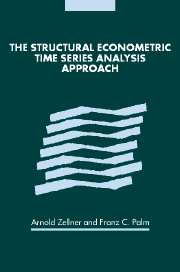Book contents
- Frontmatter
- Contents
- List of contributors
- Acknowledgments
- Introduction
- Part I The SEMTSA approach
- 1 Time series analysis and simultaneous equation econometric models (1974)
- 2 Statistical analysis of econometric models (1979)
- 3 Structural econometric modeling and time series analysis: an integrated approach (1983)
- 4 Time series analysis, forecasting, and econometric modeling: the structural econometric modeling, time series analysis (SEMTSA) approach (1994)
- 5 Large-sample estimation and testing procedures for dynamic equation systems (1980)
- Part II Selected applications
- Part III Macroeconomic forecasting and modeling
- Part IV Disaggregation, forecasting, and modeling
- Subject index
- Author index
- References
3 - Structural econometric modeling and time series analysis: an integrated approach (1983)
Published online by Cambridge University Press: 24 October 2009
- Frontmatter
- Contents
- List of contributors
- Acknowledgments
- Introduction
- Part I The SEMTSA approach
- 1 Time series analysis and simultaneous equation econometric models (1974)
- 2 Statistical analysis of econometric models (1979)
- 3 Structural econometric modeling and time series analysis: an integrated approach (1983)
- 4 Time series analysis, forecasting, and econometric modeling: the structural econometric modeling, time series analysis (SEMTSA) approach (1994)
- 5 Large-sample estimation and testing procedures for dynamic equation systems (1980)
- Part II Selected applications
- Part III Macroeconomic forecasting and modeling
- Part IV Disaggregation, forecasting, and modeling
- Subject index
- Author index
- References
Summary
Introduction
An important and difficult part of econometric modeling is the specification of the model. Any applied econometrician knows how troublesome it can be to obtain a satisfactory specification of the model. While the problem of specification analysis has received increasing attention in econometric research in recent years, many of the existing econometric textbooks provide few guidelines on how to obtain a satisfactory specification. This is surprising as the specification of the model is necessary in order to justify the choice of an estimation or testing procedure among the large variety of existing procedures, the properties of which are well established given that the true model is known. The consequences of misspecification errors due to the exclusion of relevant explanatory variables are more extensively discussed in standard textbooks on econometrics. Misspecification tests such as the Durbin–Watson test belong to the tools of any empirical econometrician. Among the exceptions to what has been said about the treatment of specification analysis in textbooks, we should mention the book by Leamer (1978), in which he distinguishes six types of specification searches and presents solutions for each of them within a Bayesian framework. But the present state of econometric modeling leads us to stress once more Zellner's (1979, p. 640) conclusion concerning the research on structural econometric models (SEMs): “Most serious is the need for formal, sequential statistical procedures for constructing SEMs.”
- Type
- Chapter
- Information
- The Structural Econometric Time Series Analysis Approach , pp. 96 - 174Publisher: Cambridge University PressPrint publication year: 2004
References
- 1
- Cited by



